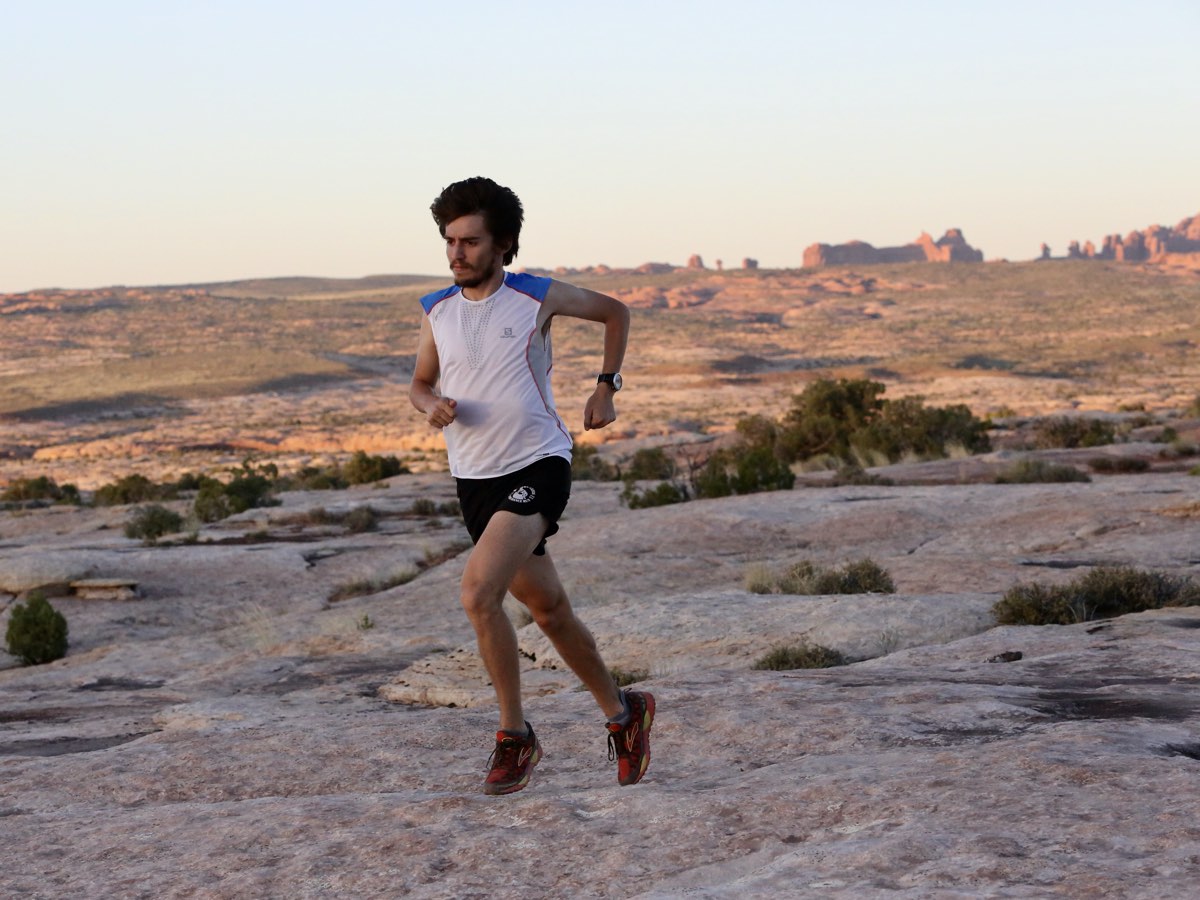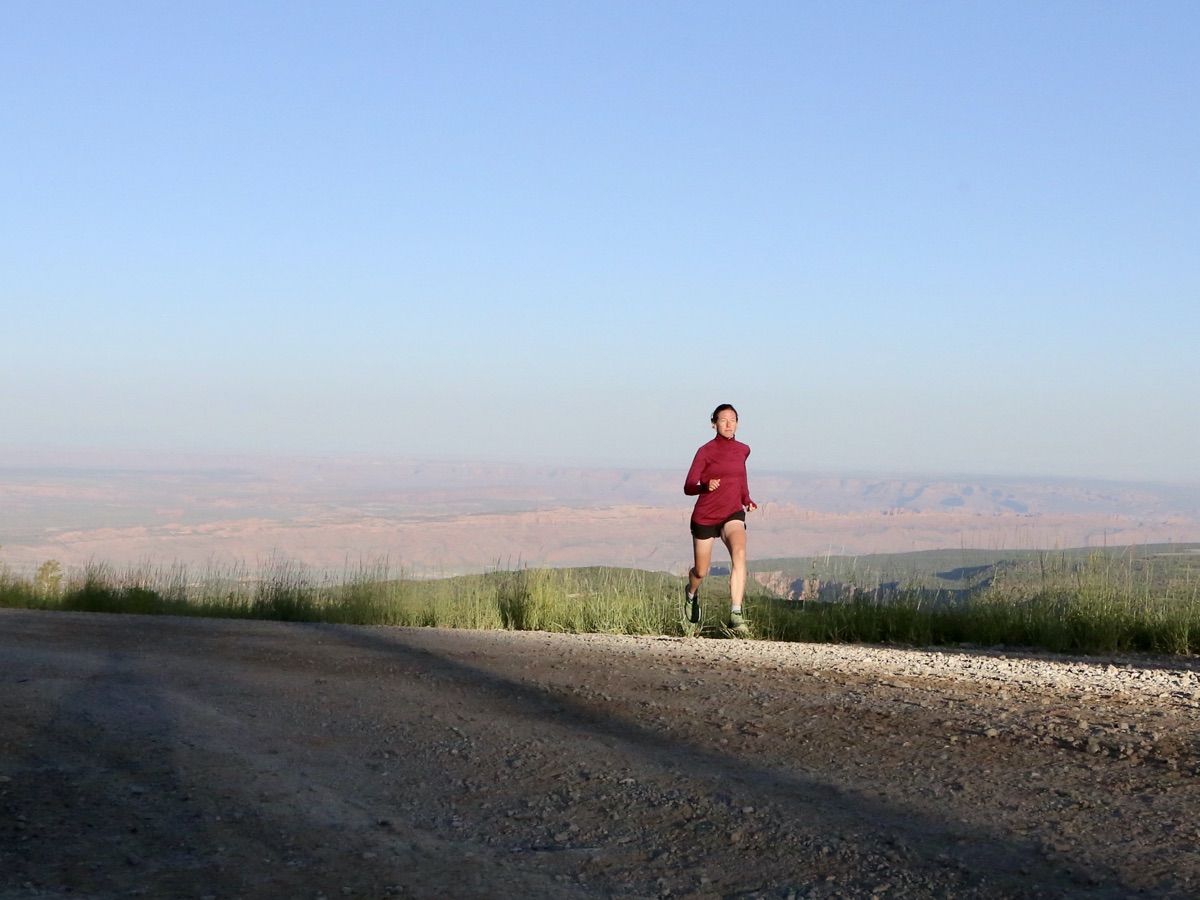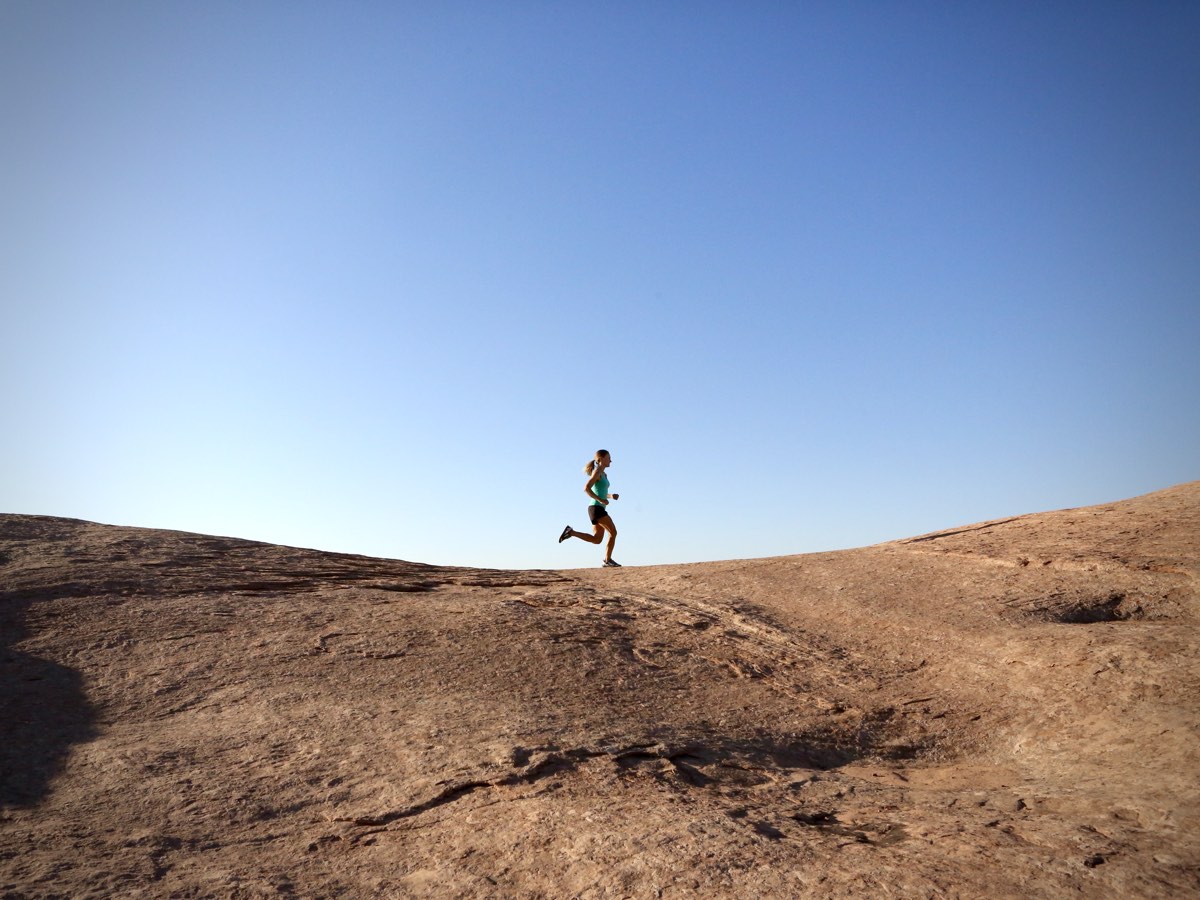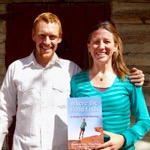
Like this article? Get your copy of the book “Where the Road Ends!”
Welcome to this month’s edition of “Where the Road Ends: A Guide to Trail Running,” where we’re talking about training for trail running.
“Where the Road Ends” is the name of both this column and the book Meghan Hicks and Bryon Powell of iRunFar published in 2016. The book Where the Road Ends: A Guide to Trail Running is a how-to guide for trail running. We worked with publisher Human Kinetics to develop a book offering the information anyone needs to get started, stay safe, and feel inspired with their trail running. The book Where the Road Ends teaches you how to negotiate technical trails, read a map, build your own training plan, understand the basics of what to drink and eat when you run, and so much more.
This column aims to do the same by publishing sections from the book as well as encouraging conversation in the comments section of each article. We want you to feel inspired and confident as you start trail running as well as connected to iRunFar’s community of off-road runners.
In this article, we excerpt from Chapter 8 and talk about training for trail running. If you’re reading this, then chances are you’re interested not only in being a trail runner but also in being a better, stronger, more comfortable trail runner. This article will help you make that happen!
When training for trail running, there are five basic types of workouts used by runners of all kinds:
- easy runs
- recovery runs
- long runs
- speedwork
- hill workouts
These five tools can make any runner better, and each has a distinct purpose. In this article, we discuss speedwork. Click on the links below to dive into the three other parts of this four-part training mini-series:
Why Should We Do Speedwork?
Putting the pedal to the metal is not only a blast but also will make you a better trail runner. Although speedwork should make up only a small portion of the running you do, it can improve all of your running, no matter the speed.
With speedwork, you attempt to increase:
- your lactate threshold (the running speed at which lactate begins to accumulate in your muscles and bloodstream and therefore affects your running);
- your VO2max (the amount of oxygen your body can absorb during a minute of the fastest running you can possibly tolerate); and
- your running economy (the physiological and biomechanical efficiency of your running stride).
These gains transfer to your slower running. For example, an increase in your running economy makes your slower running more efficient.
The balance of this article introduces various types of speedwork, the effects that each has on the body, and ways to implement them on the trails.

Practicing fast running will make all the running we do more efficient. Photo: Human Kinetics/Kirsten Kortebein
Fartlek Runs
Fartlek means “speed play” in Swedish. Unlike the more structured types of speedwork described below, the basis of fartlek runs is their unstructured nature. The entire concept is that you play with speed over the course of a fartlek run. Fartleks are great for runners who are new to speedwork, or who aren’t interested in more structured kinds of speed training. With fartleks, you’ll reap the benefits of running fast, but you’ll do so in a creative way.
First, warm up for 20 or 30 minutes at an easy effort. Then jump into the speed play. By its nature, your speed play will vary, but it should include time running faster followed by time running slower to recover. You repeat this faster and then slower combination a number of times. The speed and duration of your faster running can vary among one fartlek run. For example, you could run hard for 2 minutes, easy for 3 minutes, even harder for 45 seconds, easy for 3 minutes, and so forth. Just make sure to include enough recovery running in between fast running so that you can do each bit of faster running feeling nearly as good as you did during the previous one.
After your fartlek, make sure to do a cool down wherein you run at an easy, conversational effort for at least 15 minutes. The total length or time of your fartlek run, including the warm up, speed play, and cool down, will vary depending on your conditioning and goals, but keep the total distance of your faster running to no more than 2 miles (3 kilometers) if you are new to fartleks or 6 miles (10k) if your body is more acclimated to speedwork.
Although technical or steep terrain is detrimental to some speedwork, such terrain can enhance a fartlek. For example, you could use a meadow that separates two stands of trees or a shorter uphill to define the length of your fast running. You could then accentuate your recovery period with a section of flat or gentle downhill terrain. Defining the hard and easy sections of your fartlek using your natural surroundings makes this kind of running even better!
Steady-State Runs
Steady-state runs work on your lactate threshold, the speed you run when more lactate, a by-product of running, is produced than your body can utilize and it begins to accumulate in your body’s muscles and bloodstream. At slower running speeds, the body uses lactate as quickly as it is produced. But as your running speed increases, so does lactate production, and your body reaches a point where it is unable to clear the lactate as fast as it is produced. This point is your lactate threshold. You cannot run for very long at speeds above your lactate threshold because your body tolerates the buildup of only so much lactate before you must slow down and wait for your body to process it.
Lactate threshold varies from runner to runner, but for all runners, it ultimately limits the length of time you can run at faster speeds. You can increase your lactate threshold by running just below it for short periods, which can help train the body to efficiently clear lactate.
Greg McMillan is a renowned running coach and owner of the McMillan Running Company. McMillan recommends running steady-state runs at an effort you would race at for races lasting from 75 minutes to 2.5 hours, which equates to about 83 to 87 percent of your maximum heart rate, and which should be just under your lactate threshold.
You can also do a steady-state run by effort. Find an effort that feels like an easy challenge at the start. You will be putting some effort into it, but you might wonder if you are possibly going too slowly. Stick with the pace because maintaining it will get harder. In the end, you should be able to maintain the same pace, but doing so will require focus and concentration.
Like a fartlek, a steady-state run should begin with a warm up and end with a cool down. A 20- to 30-minute warm up should feel like an easy run, and the 15- to 20-minute cool down should be like a recovery run. Like all speedwork, the length of your steady-state sessions will vary. Runners new to speedwork might try a run in which the steady-state portion lasts 20 minutes, whereas those who are more experienced could build up to an hour of running in the steady-state zone.
You can easily run a steady-state workout on trails, roads, or a mix of both. If you run on a trail, monitor your effort when the trail pitches up or down so that you don’t overdo or underdo it. Doing steady-state runs or any of the faster speedwork described in the following sections on technical trails is not recommended. The technicality can distract you from monitoring your effort, and the navigation of rocks and roots can slow your speed to the point that you are no longer working at the intended effort level. The best sort of trail for speedwork is one with a relatively even surface over flat to rolling terrain.
Tempo Runs
A tempo run is another type of lactate-threshold run in which you run the fast part faster and for less time than you do in a steady-state run. The fast part of a tempo run is generally run at your lactate-threshold effort, such that you are accumulating significant lactate in your body as you run, explains Olympic marathoner turned trail runner Magda Boulet. Herein is the challenge of a tempo run: pushing through that accumulating lactate, which makes your legs feel like they are burning or weighed down with lead. Boulet says, “This pace should feel comfortably hard. This pace is a little faster than marathon pace, but slower than the pace you can maintain for 30 minutes.”
McMillan recommends doing tempo runs at an effort you could race at for 40 to 75 minutes, which equates to 85 to 90 percent of your maximum heart rate. If you want to do a tempo run by effort, choose an effort that feels like you are working pretty hard, but not so hard you can’t continue for up to 30 minutes. You should be able to speak in short sentences through the workout’s duration.
After an adequate warm up and before your cool down, run at tempo effort for 15 to 30 minutes. When you start doing these runs, you will find that 15 minutes is a challenging amount of time at tempo effort. But as your body adapts, you will find that you can increase the amount of time you run at this effort without an increase in deleterious effects that make you slow down. This adaptation process is precisely what you’re shooting for. “These runs are my bread and butter,” says Boulet. “I aim for a total of 30 to 60 minutes of running at threshold pace each week.” If you run a tempo run on the trail, choose a benign one.

The author, Meghan Hicks, running at steady-state effort on a dirt road. Photo: Human Kinetics/Kirsten Kortebein
VO2max Intervals
VO2max intervals approach the fastest speedwork we do, and they are meant to be conducted just below or at VO2max. Your VO2max is the amount of oxygen your body can absorb during a minute of the fastest running you can tolerate. Basically, your VO2max is a measurement of the fitness of your aerobic system. Like lactate threshold, it varies naturally among humans over the course of a lifetime and over the course of training cycles. The good news is that if you run near or at your VO2max, you can increase it.
If you’ve ever had to sprint a couple blocks for the bus or pushed a middle-distance run in gym class, then you know that running near or at your VO2max is extremely difficult. You can do it for only a very short time before your body automatically slows. For that reason, VO2max workouts are run as intervals. In these intervals, you run for a short time at or just below your VO2max effort and then slow to a jog to recover for the same amount of time. You repeat this sequence anywhere from 4 to 12 or more times. Interval lengths can range from 400 meters to 1 mile (1,600m).
McMillan says to run the intervals at an effort you could sustain for a race lasting from 5 to 25 minutes. The shorter the intervals you do, the faster you can go, and the longer the intervals you do, the slower you go. Max King recommends that you run these VO2max intervals at between 90 and 95 percent of your maximum heart rate. To go by effort, stride your body out not quite as fast as you can go but getting there, and then tone things down by one or more clicks, depending on the length of your intervals.
Your recovery between intervals is as important as the fast running. Your recovery periods of slow jogging should be the same duration as your intervals. Obviously, you will cover much less distance, but the time at recovery effort is crucial.
As with all speedwork, you’ll want to warm up and cool down.
One of the beauties of VO2max intervals is the diversity. You can use hundreds of combinations of intervals to create a solid VO2max interval workout. Here are a couple examples:
- 4 × 400 meters with equal recovery time
- 6 × 1 mile (1,600m) with equal recovery time
- 2 × 400 meters, then 2 × 1,000m, and finally 2 × 400 meters with equal recovery time
In trying a VO2max workout for the first time, run just a couple of shorter intervals. You’ve run enough when you’re unable to maintain the same pace as when you started the workout. After you start getting comfortable with the pace, try running up to 1.5 miles (2.4 km) at VO2max effort over the course of your whole workout. Runners experienced in speedwork can tackle up to 4 miles (6.4 km) at VO2max pace, and up to 8 miles (13 km) at a bit below VO2max pace.
Run VO2max workouts on a track, pavement, or only the most manicured of trails.
Excerpted from Where the Road Ends: A Guide to Trail Running, by Meghan Hicks and Bryon Powell. Human Kinetics © 2016.
Call for Comments
- If you’re just getting into trail running, what questions do you have about speedwork?
- Do you have any speedwork advice, things that you wish you knew when you started running?

